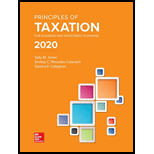
Principles Of Taxation For Business And Investment Planning 2020 Edition
23rd Edition
ISBN: 9781259969546
Author: Sally Jones, Shelley C. Rhoades-Catanach, Sandra R Callaghan
Publisher: McGraw-Hill Education
expand_more
expand_more
format_list_bulleted
Question
Chapter 4, Problem 3TPC
To determine
Determine the investment that could provide greater
Expert Solution & Answer
Want to see the full answer?
Check out a sample textbook solution
Students have asked these similar questions
Need help with this general accounting question not use ai
What is the gross margin for September on these general accounting question?
Solve this following requirements on these general accounting question
Chapter 4 Solutions
Principles Of Taxation For Business And Investment Planning 2020 Edition
Ch. 4 - Prob. 1QPDCh. 4 - Mrs. K is about to begin a new business activity...Ch. 4 - Prob. 3QPDCh. 4 - On the basis of the discussion in this chapter and...Ch. 4 - Prob. 5QPDCh. 4 - Why do income shifts and deduction shifts usually...Ch. 4 - Prob. 7QPDCh. 4 - Prob. 8QPDCh. 4 - Prob. 9QPDCh. 4 - Prob. 10QPD
Ch. 4 - Identify the reasons why managers should evaluate...Ch. 4 - Prob. 12QPDCh. 4 - Prob. 13QPDCh. 4 - Prob. 14QPDCh. 4 - Using the 2019 corporate tax rate: a. What are the...Ch. 4 - Refer to the individual rate schedules in Appendix...Ch. 4 - Refer to the individual rate schedules in Appendix...Ch. 4 - Ms. JK recently made a gift to her 19-year-old...Ch. 4 - Firm A has a 21 percent marginal tax rate, and...Ch. 4 - Prob. 6APCh. 4 - Prob. 7APCh. 4 - Firm M and Firm N are related parties. For the...Ch. 4 - Company K has a 30 percent marginal tax rate and...Ch. 4 - Firm H has the opportunity to engage in a...Ch. 4 - What is the effect on the NPV of the restructured...Ch. 4 - French Corporation wishes to hire Leslie as a...Ch. 4 - Corporation R signed a contract to undertake a...Ch. 4 - Prob. 14APCh. 4 - Lardo Inc. plans to build a new manufacturing...Ch. 4 - Prob. 16APCh. 4 - Prob. 17APCh. 4 - Prob. 18APCh. 4 - Prob. 19APCh. 4 - Prob. 20APCh. 4 - Refer to the facts in the preceding problem. At...Ch. 4 - For each of the following scenarios, indicate...Ch. 4 - Assume that Congress amends the tax law to provide...Ch. 4 - Firm L has 500,000 to invest and is considering...Ch. 4 - Prob. 1IRPCh. 4 - Mr. and Mrs. K own rental property that generates...Ch. 4 - Prob. 3IRPCh. 4 - Prob. 4IRPCh. 4 - Prob. 5IRPCh. 4 - Prob. 6IRPCh. 4 - Prob. 7IRPCh. 4 - Firm HR is about to implement an aggressive...Ch. 4 - Prob. 1TPCCh. 4 - Prob. 2TPCCh. 4 - Prob. 3TPCCh. 4 - Ms. Z has decided to invest 75,000 in state bonds....
Knowledge Booster
Similar questions
- Please need answer the general accounting questionarrow_forwardDiscuss the accounting treatment for investments in debt and equity securities.arrow_forwardSaved Required information [The following information applies to the questions displayed below.] On December 1, Jasmin Ernst organized Ernst Consulting. On December 3, the owner contributed $84,310 in assets to launch the business. On December 31, the company's records show the following items and amounts. $ 10,200 Cash withdrawals by owner Cash Accounts receivable 15,200 Consulting revenue Office supplies 3,550 Rent expense Land 45,990 Office equipment 18,310 Accounts payable 8,740 Salaries expense Telephone expense Miscellaneous expenses Owner investments 84,310 $ 2,340 15,200 3,910 7,350 790 610 Use the above information to prepare a December 31 balance sheet for Ernst Consulting. AC Graw Hill ERNST CONSULTING Balance Sheet December 31 $ 0 G-SYNC $ 0 S 0 Barrow_forward
- Audit, Fraud, Or Forensic Accounting Introduce yourself to your peers by sharing something unique about your background. Explain how you expect this course will help you move forward in your current or future career. This course covers forensic accounting, so it's important to establish the differences between an audit, a fraud examination, and a forensic accounting engagement. Think about the fraud conviction of Elizabeth Holmes, as described in the video, "Elizabeth Holmes Found Guilty in Theranos Fraud Trial." Then respond to the following: Imagine you are assigned to the Theranos case. Write the first five questions you would ask if you were an auditor, the first five questions as a fraud examiner, and the first five as a forensic accountant. After your questions, explain why the questions and approaches are different among the three roles. Be sure to respond to at least one of your classmates' posts.arrow_forwardFinancial Account subjectarrow_forwardACCOUNT QUESTIONSarrow_forward
- Provide answer general Accounting questionarrow_forwardDegregorio Corporation makes a product that uses a material with the following direct material standards: Standard quantity 2.7 kilos per unit Standard price $9 per kilo The company produced 5,700 units in November using 15,760 kilos of the material. During the month, the company purchased 17,830 kilos of direct material at a total cost of $156,904. The direct materials purchases variance is computed when the materials are purchased. The materials quantity variance for November is: a. $3,330 F b. $3,236 F c. $3,330 U d. $3,236 Uarrow_forwardNonearrow_forward
arrow_back_ios
SEE MORE QUESTIONS
arrow_forward_ios
Recommended textbooks for you
 Individual Income TaxesAccountingISBN:9780357109731Author:HoffmanPublisher:CENGAGE LEARNING - CONSIGNMENT
Individual Income TaxesAccountingISBN:9780357109731Author:HoffmanPublisher:CENGAGE LEARNING - CONSIGNMENT

Individual Income Taxes
Accounting
ISBN:9780357109731
Author:Hoffman
Publisher:CENGAGE LEARNING - CONSIGNMENT




